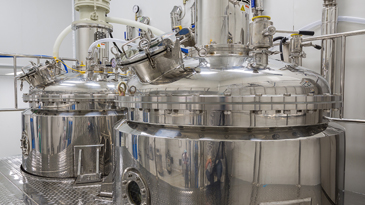Industry consultant ARC Advisory Group consistently ranks AspenTech ahead of other providers in engineering and process control solutions for the chemical industry. Earning steady praise doesn’t mean we rest on our success. As the market becomes ever more competitive, we continually seek out new ways to help our customers boost capability across the business, enabling improved connectivity and integration throughout the organization.
We launched our latest developments this month, with the release of aspenONE Version 11 and enhancements to multivariate analytics solution Aspen ProMV™. V11 offers several new capabilities to improve optimization throughout the entire asset lifecycle. A key enabler for chemicals companies are digital solutions that better align operations with planning. Some refer to this as closing the gap in performance, and many companies name this business alignment vertical integration. Regardless of the terms, this alignment enables operators to run harder, set more ambitious planning goals and achieve higher asset utilization and performance against these new goals.
For large bulk chemical operators, closing the gap between plan and performance can translate to millions of dollars of savings each year. Conservative estimates for olefins units, for example, indicate savings of at least $6 per metric ton of product by combining planning and advanced process control models across several assets, a solution known as dynamic optimization. This connection helps to maximize utilization throughout large integrated sites by increasing throughput, yield and energy savings. The key to value is ensuring that optimization encompasses multiple assets, instead of a single unit in isolation. This solution has been successfully applied to refinery sites and is now being used in olefin complexes as well.
For specialty chemicals and polymer companies, V11 offers new collaboration platforms that share detail and insight across the supply chain and into operations. Customer order changes can be very disruptive to operations planning in complex specialty businesses, and often quick and uninformed decisions lead to large profit losses. Better visibility into schedule disruptions drive better decision-making, improved efficiencies and higher margins in operations. Beta-testing partner Hexion confirmed: “We anticipate a reduction in schedule upsets as we enable manufacturing to easily communicate schedule issues well in advance of them becoming production issues.”
V11 also includes improvements on batch simulation models that can enable a faster time to market for new products. Batch processes, which are fundamental to many specialty chemicals products, can now be modeled on a single batch flowsheet, capturing the steps from reaction and crystallization through to filtration and drying.
Batch processes are also the focus for the latest update of Aspen ProMV. This solution analyzes interrelated process and laboratory data to uncover the underlying reasons for production inconsistencies. It provides insights that enable companies to better target the best operating environment to ensure consistent and on-spec product.
In the new online batch version launched this month, this analysis can proceed online and in the background, predicting batch outcomes, aligning data throughout the process, and updating the forecast of the process duration. The analysis identifies any deviation from normal range of batch behavior and gives actionable insight to operators who can intervene and make adjustments before the batch is lost.
With these new offerings, AspenTech continues to provide best-in-class solutions for the complex challenges in the chemicals industry. See what else is new in V11.
We launched our latest developments this month, with the release of aspenONE Version 11 and enhancements to multivariate analytics solution Aspen ProMV™. V11 offers several new capabilities to improve optimization throughout the entire asset lifecycle. A key enabler for chemicals companies are digital solutions that better align operations with planning. Some refer to this as closing the gap in performance, and many companies name this business alignment vertical integration. Regardless of the terms, this alignment enables operators to run harder, set more ambitious planning goals and achieve higher asset utilization and performance against these new goals.
For large bulk chemical operators, closing the gap between plan and performance can translate to millions of dollars of savings each year. Conservative estimates for olefins units, for example, indicate savings of at least $6 per metric ton of product by combining planning and advanced process control models across several assets, a solution known as dynamic optimization. This connection helps to maximize utilization throughout large integrated sites by increasing throughput, yield and energy savings. The key to value is ensuring that optimization encompasses multiple assets, instead of a single unit in isolation. This solution has been successfully applied to refinery sites and is now being used in olefin complexes as well.
For specialty chemicals and polymer companies, V11 offers new collaboration platforms that share detail and insight across the supply chain and into operations. Customer order changes can be very disruptive to operations planning in complex specialty businesses, and often quick and uninformed decisions lead to large profit losses. Better visibility into schedule disruptions drive better decision-making, improved efficiencies and higher margins in operations. Beta-testing partner Hexion confirmed: “We anticipate a reduction in schedule upsets as we enable manufacturing to easily communicate schedule issues well in advance of them becoming production issues.”
V11 also includes improvements on batch simulation models that can enable a faster time to market for new products. Batch processes, which are fundamental to many specialty chemicals products, can now be modeled on a single batch flowsheet, capturing the steps from reaction and crystallization through to filtration and drying.
Batch processes are also the focus for the latest update of Aspen ProMV. This solution analyzes interrelated process and laboratory data to uncover the underlying reasons for production inconsistencies. It provides insights that enable companies to better target the best operating environment to ensure consistent and on-spec product.
In the new online batch version launched this month, this analysis can proceed online and in the background, predicting batch outcomes, aligning data throughout the process, and updating the forecast of the process duration. The analysis identifies any deviation from normal range of batch behavior and gives actionable insight to operators who can intervene and make adjustments before the batch is lost.
With these new offerings, AspenTech continues to provide best-in-class solutions for the complex challenges in the chemicals industry. See what else is new in V11.





Leave A Comment